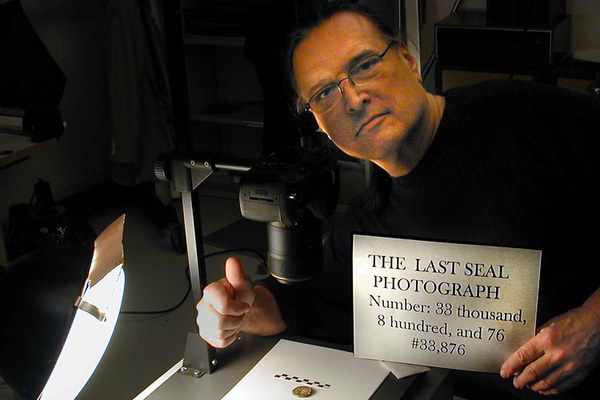Over the past four years, Dumbarton Oaks Photographer Joe Mills has taken a staggering 33,876 photographs of lead seals for the Online Catalogue of Byzantine Seals.
Dumbarton Oaks currently has 16,938 seals in its collection, the majority of which were acquired between the years of 1947 and 1977. By 2010, however, scholars had only published about 3,000 seals from the vast holdings. To speed up the publication process, Dumbarton Oaks Director Jan Ziolkowski approached Jonathan Shea, postdoctoral associate in Byzantine Sigillography and Numismatics, with the idea of establishing the online catalogue. “We thought e-cataloging would be a leap forward,” Shea says.
For the seals team, the main motivation for the Online Catalogue was twofold: access and preservation. Seals allow historians to fill gaps in histories of places and people, especially in an empire with constantly advancing and receding borders, in which titles and holdings are ephemeral, enough so to be missed by the era’s historians. “They show a lineage, a connection, and they are incredible sources for how the empire worked and who was in charge,” Shea says of seals. “There are provinces and places thought of only in seals,” he adds. An online repository, then, opens up vast new resources to scholars both within and outside of Dumbarton Oaks. “It’s all the things we don’t think to use them for but other people do,” Shea says of the catalogue’s purpose.
At the same time, lead seals are especially vulnerable to decay: each seal has a central channel through which a string was run to attach it to documents, and they often break in half along the channel. Eventually, Mills says, “All these seals are going to deteriorate into nothing.” For this reason, recording them is an essential act of preservation as well as a contribution to scholarship.
In the spring of 2011, Mills, working with Ziolkowski and Museum Director Gudrun Bühl, devised a schedule in which he would split his workweek between his standard museum photography duties and the seals project. For Mills, the bulk of the work came in the beginning, as he devised the right lighting schemes and lens configurations for the seals. “Once we determined that first seal, then it was like putting caps on toothpaste for four years,” he says.
For the duration of the project, Mills dedicated three days a week to the seals, slipping them from their small envelopes and carefully placing them on his table, capturing both the obverse and reverse faces, and then returning them to storage. He admits that his sense of timing was off: “I approached the marathon the wrong way. I thought you could just calculate how long it takes to run a mile, and multiply it by twenty-six,” Mills says. “I was wrong.”
Last year, Ziolkowski and Mills set a firm deadline for the project: February 1, 2015. Mills doubled the speed of his photography, spending the entire day staging and taking photographs as he listened to videos queued up on his computer. “You play all of the music you’ve ever heard, and then you run out, and then you’re listening to documentaries about UFOs and serial killers and ancient unknown societies,” Mills says of the process.
“I never felt like I was getting anywhere,” says Mills, who was surprised when he found that he had only fifty, and then ten, and then no seals left to photograph. “I would have gone out to have a cigar,” to celebrate after the final seal, he says, but the date he finished the project—January 27—turned out to be one of the year’s coldest days. Instead, he took a weekend trip with his wife.
Mills underscored the collaborative nature of the seals project. Now that the photographs are complete, Shea, along with sigillography consultant Eric McGeer and sigillographer John Nesbitt, will continue to work on studying the seals for publication. Throughout the process, Mills and Shea were aided by former interns Ben Selden, Lain Wilson, and Joe Glynias. In 2012, Editor in Byzantine Studies Joel Kalvesmaki devised Athena Ruby, a font that allows scholars to publish complete, accurate inscriptions from the seals.
While joking that he is busily searching the floor for the “few marbles” he lost during the photography process, Mills recognizes that these 33,876 photographs together form a highlight among his achievements at Dumbarton Oaks. “My fortieth year here is coming up, and that makes you wonder about your lasting impact,” he says. “This is about real knowledge coming together. I take a lot of pride that these are indelible things.”

